Explain THREE benefits that organizations gain from using budgetary planning and control systems.
Select ALL the true statements.
The following information is available about direct material T for the last period.
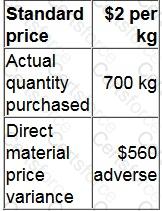
A JIT purchasing system is in operation.
Calculate the actual price paid per kg of material T.
Give your answer to 2 decimal places.
RT produces two products from different quantities of the same resources using a just-in-time (JIT) production system. The selling price and resource requirements of each of the products are shown below:
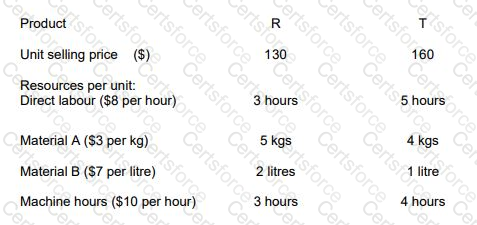
Market research shows that the maximum demand for products R and T during June 2010 is 500 units and 800 units respectively. This does not include an order that RT has agreed with a commercial customer for the supply of 250 units of R and 350 units of T at selling prices of $100 and $135 per unit respectively. Although the customer will accept part of the order, failure by RT to deliver the order in full by the end of June will cause RT to incur a $10,000 financial penalty. At a recent meeting of the purchasing and production managers to discuss the production plans of RT for June, the following resource restrictions for June were identified:
Direct labour hours 7,500 hours
Material A 8,500 kgs
Material B 3,000 litres
Machine hours 7,500 hours
Assuming that RT completes the order with the commercial customer, prepare calculations to show, from a financial perspective, the optimum production plan for June 2010 and the contribution that would result from adopting this plan.
The optimum production plan will be:
FGH used to manufacture components that required raw material Q.
Currently there are 80 kg of material Q in inventory.
The company has no use for the material in the foreseeable future and intends to sell it for scrap.
A potential new customer has asked for a price for a large order.
This order would require 100 kg of material Q.
The company management has decided to quote a price for this work on a relevant cost basis.
Details of costs for material Q are as follows:
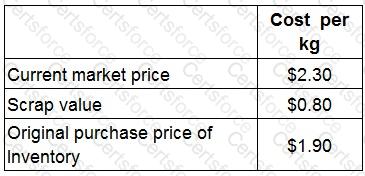
What would be the relevant cost of Material Q to use in this order?
A completed unit of Product A requires 9 kg of material and 10% of material is wasted in the production process.
Material has a standard cost of $5 per kg.
Product A also requires 4 labour hours at a standard cost of $10 per labour hour and variable overheads at a standard cost of $2 per labour hour
What is the standard variable production cost per unit of Product A?
You are a trainee management accountant working for a prestigious manufacturing firm. One day you go to a business meeting a business meeting and the managing director is there. They stand up and say that the
company is losing too much money through wastage and losses and so they have decided to implement a total quality management system. They go on to say this system will:
1:Allow the company to improve on a consistent and continual basis
2:Allow the company to identify and allocate quality accountability to certain departments
3:Help the company detect error and fraud
Are ALL of these statements correct?
A company sells two products, X and Y, which are always sold in the same ratio.
No inventories are held.
The following budgeted data relate to month 10:
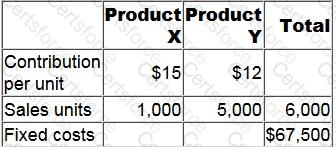
What is the budgeted margin of safety in month 10?
Rank the budgets listed below to show the order in which they should normally be prepared:
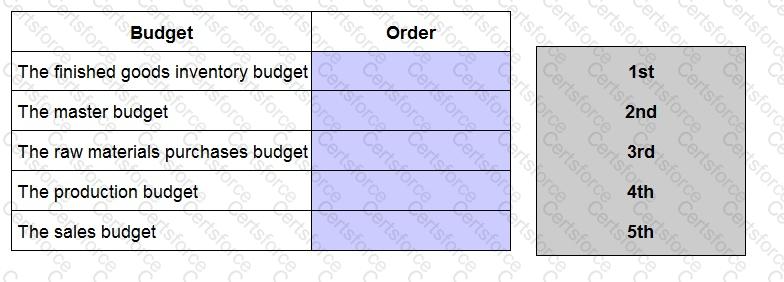
A medium-sized manufacturing company, which operates in the electronics industry, has employed a firm of consultants to carry out a review of the company’s planning and control systems. The company presently uses a traditional incremental budgeting system and the inventory management system is based on economic order quantities (EOQ) and reorder levels. The company’s normal production patterns have changed significantly over the previous few years as a result of increasing demand for customized products. This has resulted in shorter production runs and difficulties with production and resource planning. The consultants have recommended the implementation of activity based budgeting and a manufacturing resource planning system to improve planning and resource management.
What are the benefits for the company that could occur following the introduction of an activity based budgeting system?
Select ALL the correct answers.
CDF is a manufacturing company within the DF group. CDF has been asked to provide a quotation for a contract for a new customer and is aware that this could lead to further orders. As a consequence, CDF will produce the quotation by using relevant costing instead of its usual method of full cost plus pricing. The following information has been obtained in relation to the contract: Material D 40 tons of material D would be required. This material is in regular use by CDF and has a current purchase price of $38 per ton. Currently, there are 5 tons in inventory which cost $35 per ton. The resale value of the material in inventory is $24 per ton.
Components 4,000 components would be required. These could be bought externally for $15 each or alternatively they could be supplied by RDF, another company within the DF manufacturing group. The variable cost of the component if it were manufactured by RDF would be $8 per unit, and RDF adds 30% to its variable cost to contribute to its fixed costs plus a further 20% to this total cost in order to set its internal transfer price. RDF has sufficient capacity to produce 2,500 components without affecting its ability to satisfy its own external customers. However, in order to make the extra 1,500 components required by CDF, RDF would have to forgo other external sales of $50,000 which have a contribution to sales ratio of 40%.
Labour hours 850 direct labour hours would be required. All direct labour within CDF is paid on an hourly basis with no guaranteed wage agreement. The grade of labour required is currently paid $10 per hour, but department W is already working at 100% capacity. Possible ways of overcoming this problem are: • Use workers in department Z, because it has sufficient capacity. These workers are paid $15 per hour. • Arrange for sub-contract workers to undertake some of the other work that is performed in department W. The sub-contract workers would cost $13 per hour.
Specialist machine The contract would require a specialist machine. The machine could be hired for $15,000 or it could be bought for $50,000. At the end of the contract if the machine were bought, it could be sold for $30,000. Alternatively, it could be modified at a cost of $5,000 and then used on other contracts instead of buying another essential machine that would cost $45,000. The operating costs of the machine are payable by CDF whether it hires or buys the machine. These costs would total $12,000 in respect of the new contract.
Supervisor The contract would be supervised by an existing manager who is paid an annual salary of $50,000 and has sufficient capacity to carry out this supervision. The manager would receive a bonus of $500 for the additional work.
Development time 15 hours of development time at a cost of $3,000 have already been worked in determining the resource requirements of the contract.
Fixed overhead absorption rate CDF uses an absorption rate of $20 per direct labour hour to recover its general fixed overhead costs. This includes $5 per hour for depreciation.
Calculate the relevant cost of the contract to CDF. You must present your answer in a schedule that clearly shows the relevant cost value for each of the items identified above. You should also explain each relevant cost value you have included in your schedule and why any values you have excluded are not relevant.
Ignore taxation and the time value of money.
Select all the true statements.